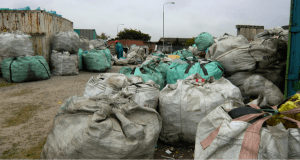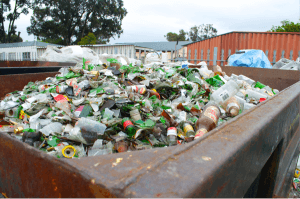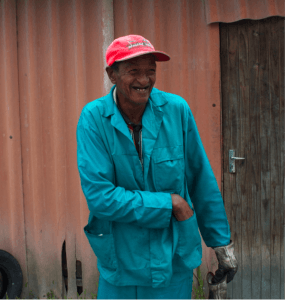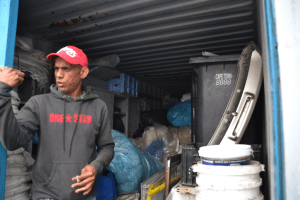Scene 2: A Tour of the Facility
Background:
During our time researching and understanding waste management options in South Africa, the team was never truly able to grasp the full extent of Blue Sky’s processes. Once the team was in Africa, they wanted to be sure that they understood the day-to-day workings of Blue Sky and how it worked. The goal was to use this information to better understand the areas for opportunity and growth within the organization.
Cast of Characters: John McKerry, Gershwin Kohler, Blue Sky Recycling Student Team
John McKerry is the team leader at Blue Sky; he leads the day-to-day business processes and manages the logistics and transportation needs of Blue Sky. In short, he runs the show when it comes to everything hands-on at Blue Sky.
Gershwin Kohler is the project leader at Blue Sky and our main liaison to the Sold Waste Picker’s Network Programme. He handles much of the financial and paper work related duties at Blue Sky.
Setting:
The sorting yard on a bleak day can be a very solemn place. With wind cutting to the bone we approached the daunting heaps of unsorted plastic waste. Shipping containers surrounded the yard, piled high with all imaginable recyclable material, anything from cardboard to broken electrical appliances. On the left of the gate was a mountain of unsorted recyclables, to the right were the sorted plastics, and in the middle, a lone man contemplating his job. In two large iron skips lay tonnes of shattered glass. The day was short but the experiences and stories formed in the yard would be useful for the team to establish and develop their understanding of Blue Sky Recycling.
Scene:
Connecting and Planning:
The group approached the tour of the facility seeking to take full advantage of their intricate access into Blue Sky’s daily workings. They sought to further their understanding of not only Blue Sky but also the process by which goals are accomplished in the yard. They also sought to identify key opportunities for improvement of efficiency within the organization. They hoped to start the conversation with their liaisons about what the needs of the facility and business were and how they could collaborate with Blue Sky to meet those needs.
Action and Observation
The group was invited to explore the yards of facility. John and Gershwin made sure to point out that not all the area that we would see belonged to Blue Sky. “The plot is actually ran by Sizakuyenza”, Gershwin described. Sizakuyenza is a community welfare organization started in partnership with CORC and Cesvi. On the premises they held anything from youth programs to a small Women and Children’s shelter. CORC was kind enough to allow Blue Sky to use some of the land, and as such much of the open space in the yard was reserved for programmes not directly related to Blue Sky.
During the tour the team was able to observe the basic processes taking place at Blue Sky, which involved sorting, some processing, and social development programmes for local community members in need of assistance. Additionally, the group was able to better assess the general working areas within the facilities, which are the major areas that our sponsors would like the project to focus on. The team plans to work with them to assess and implement the hoist, work to streamline transportation, and help Blue Sky add value to their recyclables, which will be a interesting and valuable experience.
As we entered the main yard we realised the sheer amount of work that must be done to sort and ready the materials to be sold. Lo and behold a lone 65 year old man who is responsible for sorting all of the recycling that is accumulated at Blue Sky upon pick up. A wall of unsorted plastic goods blocked the chill wind affording this man safety from at least one of the perils of his job out in the open. Thousands of pounds of material laid out before us in the expanse of the yard and in the dreary cloudy light lit a tiring mood for the afternoon. The task of making the yard into a functioning, streamlined facility seemed a large task indeed. “It may seem messy now, but we have a plan”, said John with a glint in his eye. He ran to his truck and pulled out a piece of paper. “With the help of CORC, we imagine this is how the yard will look once we can formalize everything.”
We expected working conditions to be difficult at Blue Sky from the general research that we pursued during the preparation term; these expectations were confirmed upon arrival. However, the tour of Blue Sky gave visual evidence of the areas for opportune growth. This growth would significantly improve the conditions for workers while also helping the community grow as the programme’s successes multiplied. Seeing the facility was both eye opening and humbling as we witnessed the ability to work under such confined conditions while maintaining positive attitudes geared towards hope for future success.
We toured the big containers containing stored paper and John described some of the added value processing that was done in years past. Blue Sky had jointly operated with the women’s shelter to make books out of recycled paper and resell them to paper companies. These were making a decent profit, the problem however was that it wasn’t sustainable and Blue Sky soon had to can the project due to lack of resources. “We hope that you guys have some ideas for something we can use our existing resources to build and sell and add value to our business,” John remarked.
Reflection and Learning:
Through talking with John and Gershwin we realized that there was much more social involvement of Blue Sky than had previously been expected. We knew that Blue Sky was working to better the lives of pickers but we did not realize their involvement with other organizations in the area, especially not the involvement with Sizakuyenza.
Blue Sky was primarily focused on the social aspect of the community of pickers and their responsibility to them seemed more important than their responsibility to profit as a business. This will make reaching sustainability for the programme a harder endeavor but by no means will their social duty preclude them from reaching their sustainability goals.
This organization is not about building a business with a large profit margin, but is focused on building a community. Blue Sky does not focus on recycling as much as developing the surrounding community towards a goal of sustainability and livelihood. Through limited discussion with John and Gershwin, our group has found that we will not just be working for Blue Sky. Instead, we will also be working for 300-400 families that are impacted by Blue Sky in their daily lives to foster and preserve hope and growth on a community-wide scale.
It was also amazing to hear about the passion that John and Gershwin have for their work with the people they serve. They almost never refer to the pickers as customers and indicated that Blue Sky served them and not the other way around, which is truly a beautiful thought. John made sure to note that the relationship was heavily intertwined: Blue Sky relied on pickers as much as pickers relied on Blue Sky.
During the tour, our discussions with John and Gershwin were inspiring as both leaders emphasized the importance of community on a personal level that preceded even the commonest business practices. John and Gershwin aim for a programme that benefits the community while maintaining simple sustainability as opposed to looking for the highest profit margins achievable. They offer higher rates for picked recyclables than is financially responsible as well as doing favours for customers that can be economically harmful. This passion for the community exemplified the social importance of the Blue Sky Recycling Programme that will be a key factor in collaborating towards sustainable growth within the programme.
Through the tour it was also made clear that the manpower that Blue Sky currently has access to is far less than what our group had previously expected. Although there are a large number of pickers, this is the consumer base that creates business for Blue Sky. It does not necessarily contribute to the various working processes that create profit for Blue Sky.






